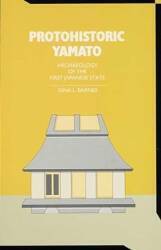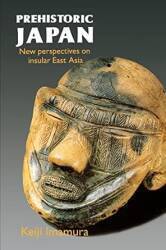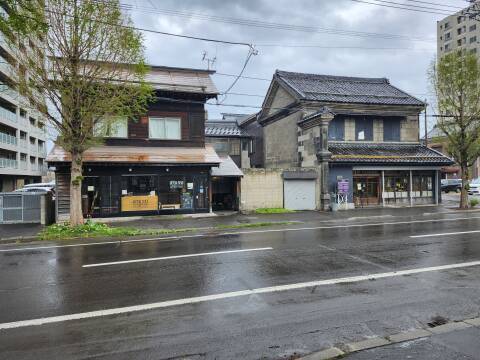
The Mausoleum of Emperor Kinmei
The Kofun of Emperor Kinmei
I finally reached a kofun associated with a figure with some historical background! Emperor Kinmei was the 29th Emperor, reigning from 539 through 571. He is the first Emperor for whom contemporary historians can find verifiable dates. Buddhism officially arrived in Japan during his reign. Buddhist monks had visited Japan a century before, but in 552 a Korean king sent envoys to the Emperor of Japan.
Asuka is about 25 kilometers south of the modern city of Nara. The Asuka Period is now considered to have begun with Emperor Kinmei's reign in 539, and to have lasted until the capital was transferred to the new Heijō Palace at Nara in 710. Up to that time, every emperor built a new palace, as it was considered dangerous to stay in a palace where a deceased Emperor's spirit might reside. Palaces were built entirely of wood, so only a few stone pillar bases have been found.
The kofun associated with Emperor Kinmei is the only keyhole-shaped kofun around Asuka.
| Location | 135.7991° E 34.4685° N |
| Length | 140 meters |
| Circle diameter | 72 meters |
| Width at base | 107 meters |
| Orientation | ~85° |
Today's town of Asuka has a population recently estimated to be 5,681. I got there from Nara on the Kintetsu railway. Asuka is near the bottom of this map, a small town south of Sakurai.

Map NI53-7 from the Perry-Castañeda Library Map Collection at the University of Texas at Austin.
I walked just a few blocks from where I was staying to the subterranean Kintetsu Nara station. I took a local train to Yamato-Saidaiji Station. The first stop was Shin-Ōmiya, where I had started a tour through several ancient tomb mounds starting with Uwanabe Kofun.
The Kintetsu line crosses the southern part of the Heijō-kyō palace, then the second station is Yamato-Saidaji where you can connect north to Kyōto, continue west to Ōsaka, or connect to the south.
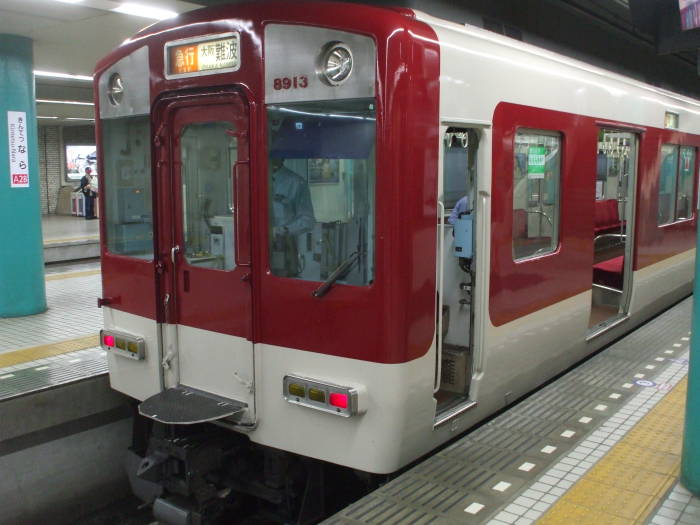
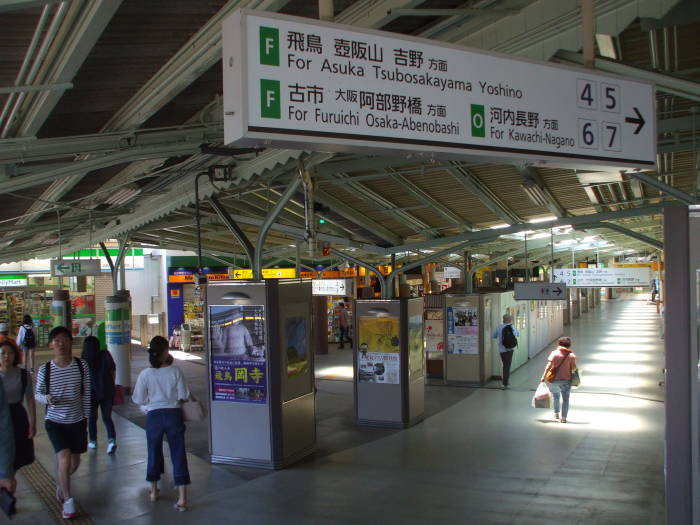
I took a local train south from Yamato-Saidaji on the west side of Nara, riding south to Kishihara-jingū-mae. After a short wait there, I continued two more stops south to Asuka.
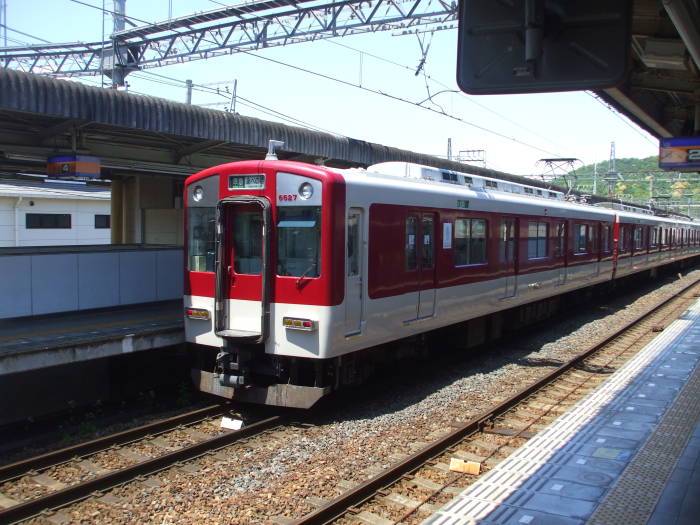
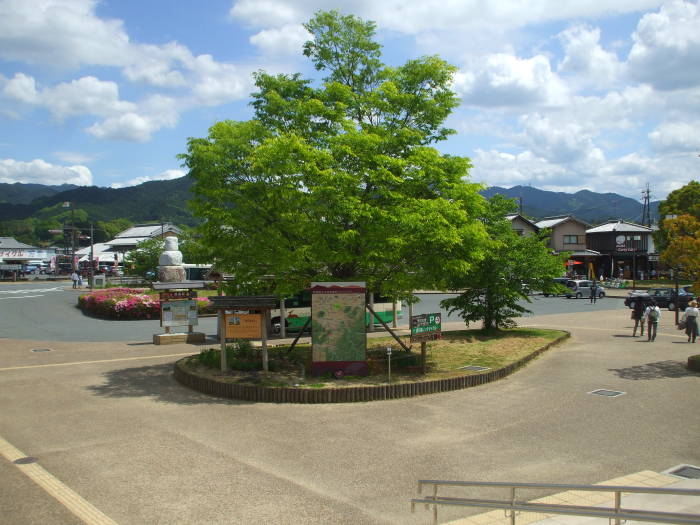
Above I have just stepped out of the Asuka Station to the large square.
The Yamato Period
| Paleolithic | before 14,000 BCE |
| Jōmon | 14,000 – 300 BCE |
| Yayoi | 300 BCE – 300 CE |
| Kofun | 300–538 |
| Asuka | 538–710 |
| Nara | 710–794 |
| Heian | 794–1185 |
The mythological first Emperors beginning with Jimmu are placed by the legends within the Jōmon Period. Japan was inhabited by a hunter-gatherer culture that developed some of the first pottery in East Asia and throughout the world. Tools were made from bone, antlers, shells, and stone. Limited horticulture had been established by its end.
Metal working technology arrived from Korea during the Yayoi Period, bronze early and iron late within the period. Intensive rice agriculture began. It now appears that farmers from the Asian continent arrived in Japan, and an agricultural society replaced the native hunter-gatherer population.
A powerful clan leader unified control over much of western Honshū and the northern half of Kyūshū toward the end of the Kofun Period. That leadership developed into the Imperial House of Japan. Japan's culture was based on Shintō during the Kofun Period.
Buddhism arrived and became the dominant cultural force during the following Asuka Period. The Kofun Period and Asuka Period together are called the Yamato Period. The ruling clan leaders, centuries later called Emperors, ruled Japan from Yamato Province during this time. Other clans ruled other regions of Japan, the Yamato court was the most successful. Chinese culture and ideas were introduced. Today the historical Yamato Province is called Nara Prefecture.
Written history, after a fashion, appeared during the Asuka Period, the latter part of the Yamato Period.
Kinmei and the Arrival of Buddhism
The Chinese Book of Liang recorded in 635 that five Buddhist monks from Gandhāra had visited Japan in 467.
According to the Jōgū Shōtoku Hōō Teisetsu, the biography of Prince Shōtoku Taishi, and the Gangō-ji Garan Engi, the "Origins of the Gangō-ji Monastery and its Assets", the King Seong Myong of Baekje on the Korean peninsula introduced Buddhism to Japan in 538. He sent a group of Buddhist monks and nuns carrying an image of the Buddha and a number of sutras introducing and explaining Buddhism.
The Kojiki (or Records of Ancient Matters) and Nihon Shoki (or Chronicles of Japan) were written in 711-720. They codified Shintō belief and practice and served, after a very sketchy fashion, as the first history of Japan. They contained a mixture of myths and geneology, formalizing the belief that the Emperors were descended from the gods. They said that King Seong Myong of Baekje sent his Buddhism mission to Japan in 552.
So, Buddhism arrived in Japan in the early to mid 6th century, maybe in 538 or 552 CE. The purported historical documents were written almost two centuries later — the Kojiki and Nihon Shoki in 711-720, the Gangō-ji Garan Engi in 747, and while parts of the Jōgū Shōtoku Hōō Teisetsu were written in the early 700s, it was only completed in 1050.
All the figures before Emperor Ōjin of the late 3rd century CD listed in the Kojiki and Nihon Shoki are legendary. Emperor Ankō of the 5th century was the earliest historical ruler of at least a part of Japan, and he appeared as the 20th Emperor in the legendary lists. Up to that time, Japan had been entirely clan-based.
Kinmei, listed as the 29th Emperor, reigned from 539 through 571. He is the first Emperor for whom contemporary historians can verify dates, places, and people. Buddhism officially arrived in Japan during his reign. The term tennō or "Emperor" wasn't used until Tenmu, the 40th ruler, who ruled 631–686. Kinmei probably would have been known as Sumeramikoto or Amenoshita Shiroshimesu Ōkimi,, meaning "The Great King Who Rules All Under Heaven", or more simply as "The Great King of Yamato".
Shintō had deified the leaders. Buddhism emphasized the transience of human life. Buddhism rapidly became the dominant philosophy and the enormous kofun tombs fell out of use.

The Kofun
The kofun is a short walk north from the train station.
A sign at the kofun says:
Also called Hinokuma-no-sakaai-no-misasagi.
[...]
The earthen mound has three tiers with a surrounding dry moat.
[...]
According to the Nihon Shoki,
the Emperor Kinmei passed away in the fourth month of
571 and was buried at Hinokuma-no-sakaai-no-misasagi
in the ninth month.
It is recorded there that Princess Kitashi, Emperor Kinmei's
wife and the mother of Emperor Suiko, was also buried there
with Emperor Kinmei in 612, and in 620 the mausoleum was
covered with gravel and an earthen mound raised over it,
each clan erecting a great pillar on the top of the
tumulus.

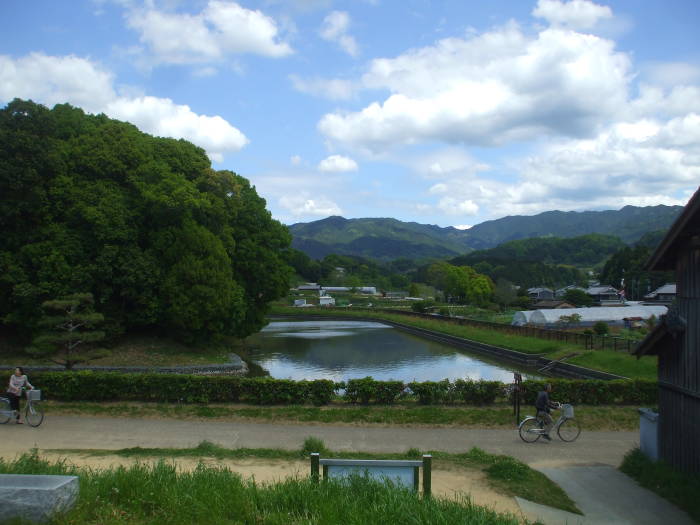



The Tomb of Princess Kibihime-no-miko
Another shrine is on a small rise overlooking the memorial of Emperor Kinmei. A sign there says:
The name of the mausoleum is Hinokuma-no-haka.
Princess Kibihime was the mother of Emperor Kotoku and
Empress Kogyoku (Saimei).
According to the Chronicles of Japan, Princess Kibihime
passed away in the ninth month of the year 643 and was
buried at a hill named Mayumi-oka.
According to the Engi shiki, her grave was located in
the same hill as that of the Emperor Kinmei.
It is therefore assumed to be at this location.
Within the area of the tomb are four stone figures, the
saru-ishi, or monkey stones, discovered during the Edo
period in a rice field in the Ikeda area to the south
of Emperor Kinmei's mound.

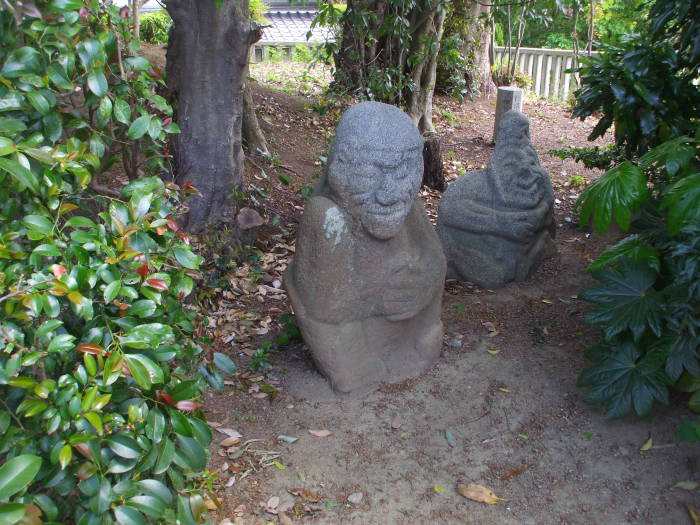

Other Megaliths
I walked on to the east, headed toward the Ishibutai kofun. The area is filled with small farms.
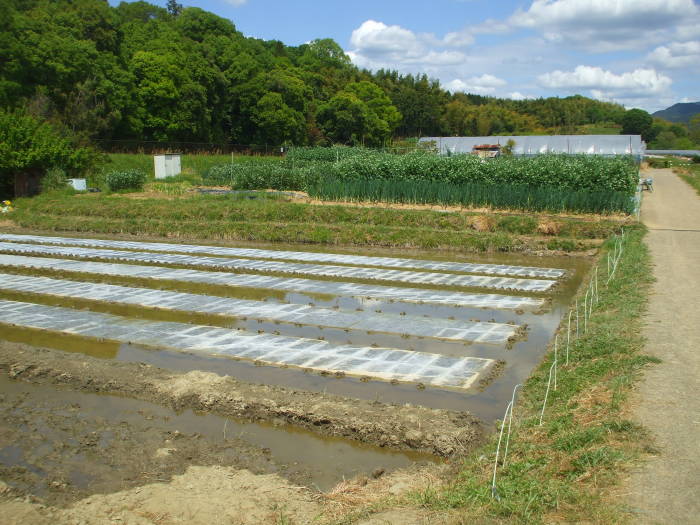
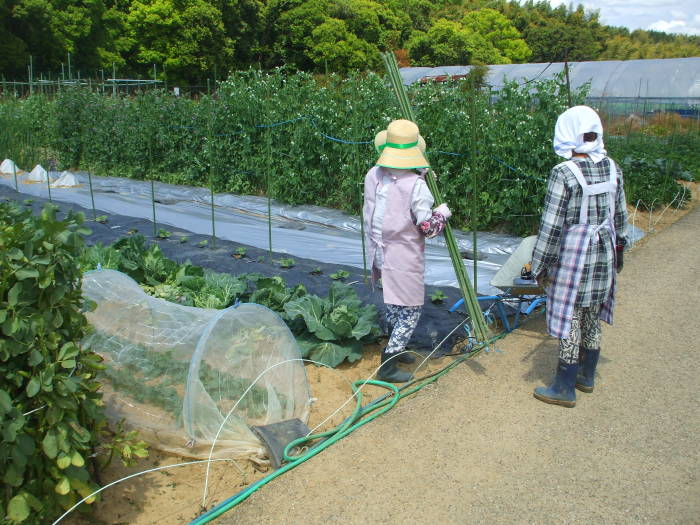
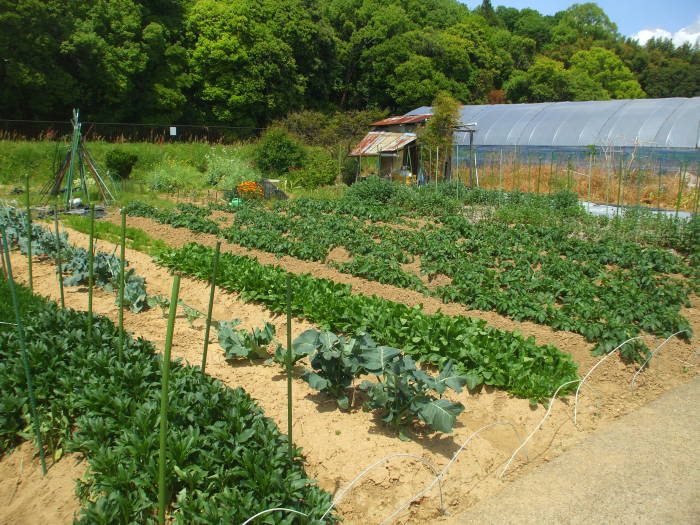
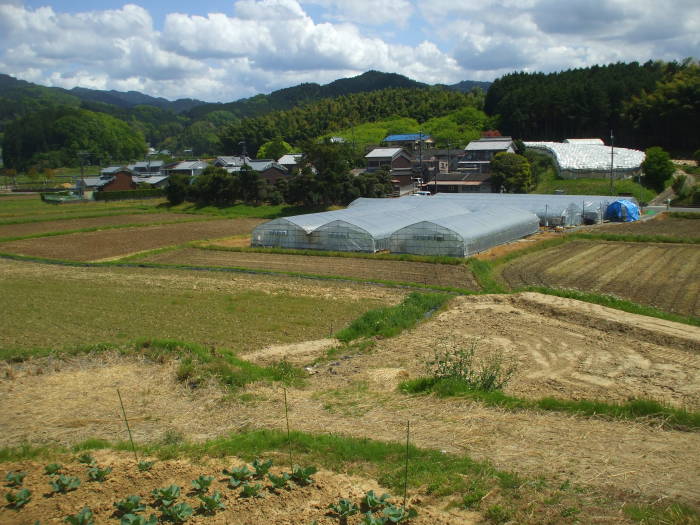
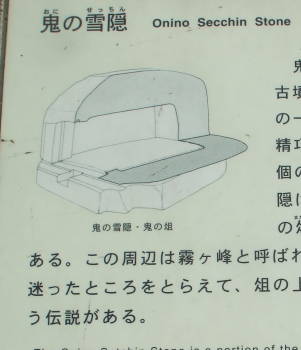
The ruins of a tomb on a nearby hillside were old enough to have been forgotten by the medieval era. The ruined tomb became the source of a confused legend. Originally the tomb had been a flat base stone with a cup-like stone inverted on top of it. The assembly had then been buried under an earthen mound.
The earthern mound had largely eroded away when a powerful earthquake shook the cover piece loose and sent it rolling down the hillside. The cover piece came to rest almost upside down, tipped up, about 50 meters down the hill.
The local people came up with a legend about these two stones.
A nearby mountain was Kirigamine, "Mist Peak". The legend said that demons lived in the area. They would cause a mist to descend. Travellers would become confused and disoriented, and the demons would capture them.
The demons would butcher the travelers on the Onino Manaita or "Demon's Cutting Board", the base of the tomb. They would eat the travelers, then relieve themselves on the Onino Setchin or "Demon's Toilet", the tilted cover that had rolled down the hill.
In the first picture below I'm approaching Onino Setchin, the "Demon's Toilet".

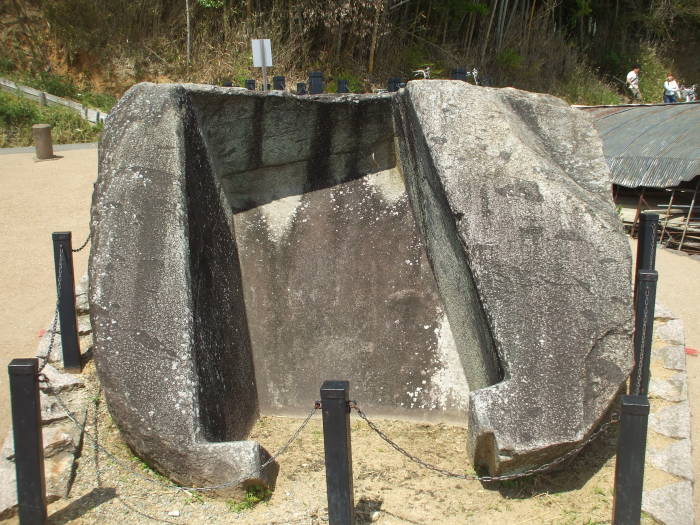
This is the a megalithic tomb cover. The two flat areas at left and right rested on the flat base stone. The rectangular volume at center was the tomb. The entryway is at the bottom here.
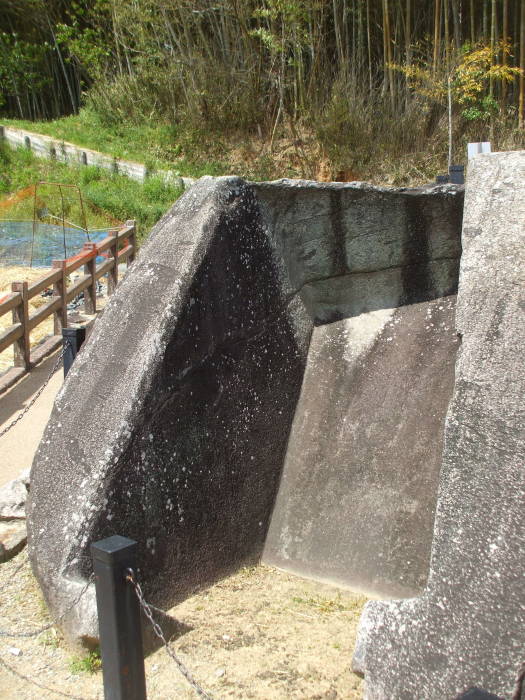
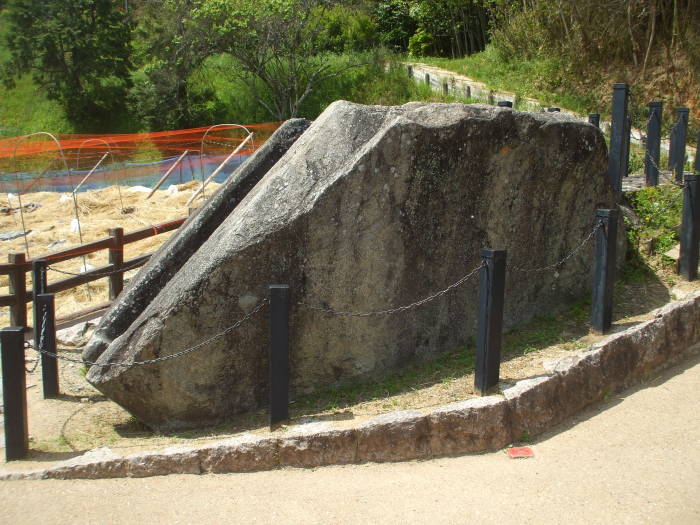

Above is Onino Manaita or the "Demon's Cutting Board".
Where next?
I continued by foot to Ishibutai Kofun.
The above is specific to the kofun around Nara. Or maybe you want to explore other places in Japan.
Other topics in Japan:
